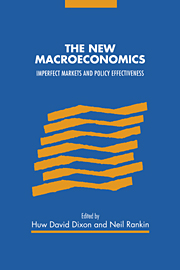Book contents
- Frontmatter
- Contents
- List of contributors
- Preface
- Acknowledgements
- Introduction
- Part I Overviews and perspectives
- Part II Goods market imperfections
- Part III Labour market imperfections
- Part IV Financial market imperfections
- Part V Nominal rigidities and bounded rationality
- 13 Hedging, multiple equilibria and nominal contracts
- 14 Information acquisition and nominal price adjustment
- 15 Expectation calculation, hyperinflation and currency collapse
- 16 Menu costs and aggregate price dynamics
- Bibliography
- Index of authors
- Index of subjects
16 - Menu costs and aggregate price dynamics
Published online by Cambridge University Press: 13 October 2009
- Frontmatter
- Contents
- List of contributors
- Preface
- Acknowledgements
- Introduction
- Part I Overviews and perspectives
- Part II Goods market imperfections
- Part III Labour market imperfections
- Part IV Financial market imperfections
- Part V Nominal rigidities and bounded rationality
- 13 Hedging, multiple equilibria and nominal contracts
- 14 Information acquisition and nominal price adjustment
- 15 Expectation calculation, hyperinflation and currency collapse
- 16 Menu costs and aggregate price dynamics
- Bibliography
- Index of authors
- Index of subjects
Summary
Introduction
The idea that small costs of adjusting prices can create significant nominal rigidities is now a well known result in macroeconomics. The basic implications of menu costs are easily derived and demonstrated in a simple static model of a monopoly firm (as in Akerlof and Yellen, 1985; Mankiw, 1985). However, there are now a number of studies which generalize this analysis, first, to consider the dynamic behaviour of an individual representative firm (Sheshinski and Weiss, 1977, 1983), and secondly, to consider the dynamic behaviour of the aggregate price level when firms are heterogeneous (Caplin and Spulber, 1987; Caplin and Leahy, 1991). This chapter brings together the main results of this literature and presents them in a unified framework which is accessible to non-specialist readers.
The chapter begins by deriving and explaining a dynamic menu cost model of an individual firm. In this context ‘dynamic’ means that the firm aims to maximize the discounted value of its profit stream while experiencing serially correlated shocks to the demand for its product. The firm therefore faces an ongoing price adjustment problem such that at every instant it must decide whether and by how much it should adjust its price level. This contrasts with the models of Akerlof and Yellen (1985b) and Mankiw (1985) where the firm experiences a single shock and is only concerned with maximizing profits within the current period.
- Type
- Chapter
- Information
- The New MacroeconomicsImperfect Markets and Policy Effectiveness, pp. 337 - 359Publisher: Cambridge University PressPrint publication year: 1995



